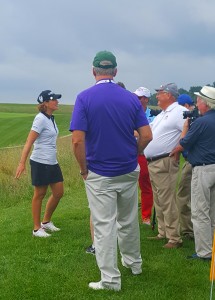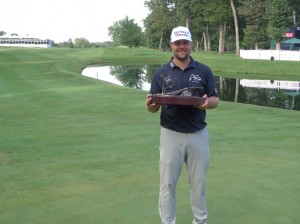Here is what’s wrong with the BMW Championship, which is coming up Sept. 8-11 at Crooked Stick in Indianapolis.
For one, it’s not Chicago based. When the Western Golf Association replaced the history-rich Western Open in favor of the BMW Championship in 2007 that ended a 45-year run for Chicago being an annual PGA Tour stop. Now it’s every other year, and this time Crooked Stick gets to host for the second time.
For another, being a FedEx Cup Playoff event, you’re never sure exactly who will be playing until a few days beforehand and some of golf’s most popular players are certain to be missing.
All that may sound on the negative side, but there are good reasons for things being the way they are.
The rotation of sites has been financially rewarding to the WGA’s Evans Scholars program – and that is the reason for holding the event in the first place. Rather than make an annual stop at the same course, the WGA freshened the event by playing it outside Chicago in alternate years. Markets that don’t get big-time golf events very often are more than receptive when the PGA Tour does come to town. Indianapolis is just one of those.
Bigger crowd, bigger profits, more opportunities for deserving caddies to go to college. It’s hard to argue with that reasoning, and the WGA is carrying that logic further. Next year’s staging will be the third and last at Conway Farms, in Lake Forest, and the road show goes to Aronimink, a well-regarded club in the Philadelphia area, in 2018. After that the BMW Championship may be rotating among Chicago clubs on the alternate years as well.
That policy hasn’t been announced, but Medinah will be the site in 2019. Then, who knows? BMW’s contract with the PGA Tour is up after that event, opening all kinds of possibilities for subsequent years.
Time will take care of all those details, but firming up the field early for any of the four FedEx Cup Playoff event – much less No. 3 in the rotation – is impossible.
That’s not all bad, though. While some stars might not be there, one thing is certain: the 70-player field will be very, very good. The competitive format for the playoffs assures that.
Here’s how it works:
The top 125 players on the season-long FedEx Cup point race got into the first playoff event – The Barclays in New York the last week of August. They played 72 holes without a 36-hole cut for an $8.5 million prize fund and the top 100 on the point race afterwards got a chance to do it again.
Second event in the FedEx Cup is the Deutsche Bank Championship Sept. 2-5 at TPC Boston. It has the same format as The Barclays – 72 holes with no 36-hole cut, another $8.5 million available in prize money and the top 70 on the point list get to do it again.
That’s where the BMW Championship comes into the picture. The top 70 play for another $8.5 million in another 72-hole, no cut event at Crooked Stick.
Finally, the top 30 on the point list after the BMW Championship advance to The Tour Championship at East Lake in Atlanta for the final $8.5 million, 72-hole no-cut tournament. A lot of prize money is obviously on the line in September but there’s more to it than tournament checks. The winner of the FedEx Cup point race – and that’s not necessarily the winner of The Tour Championship – gets an additional $10 million bonus.
During the course of the FedEx Cup season there were 43 regular season tournaments to decide who would qualify for the playoffs. There were 247 players earning points towards inclusion in the playoffs and a good showing in the “post-season’’ would make up for disappointing showings in the four major championships by some of the game’s elite players.
In this year’s jumbled schedule the four majors – due to the inclusion of golf in the Olympic Games for the first time in 112 years – lost some of their luster. At least three of the top young players did, too. Neither Jason Day, Rory McIlroy nor Jordan Spieth won a major in 2016. Winning the FedEx Cup would at least help make up for that unexpected shortcoming.
The majors, in case you’ve forgotten, went to Danny Willett (Masters), Dustin Johnson (U.S. Open), Henrik Stenson (British Open) and Jimmy Walker (PGA Championship). McIlroy didn’t even challenge in any of those and missed the cut at both the U.S. Open and PGA Championship.
Day, the current world No. 1, made a great run at the PGA but came up a shot short. Spieth had a successful defense of his Masters title in hand until he took a quadruple bogey seven on the 12th hole of the final round. Of the Day-McIlroy-Spieth trio and the four major championship winners, only Stenson and Willett opted to play in the Olympics and only Stenson and Spieth are past FedEx Cup champions.
So, September is FedEx Cup time and this year reputations are on the line as well as financial considerations. With eight different winners in nine years, the Playoff has had a wide variety of champions and this year’s competition figures to be even more wide-open than previous years.
Only Tiger Woods (2007 and 2009) has won the FedEx Cup twice and he isn’t playing this time. The other champions were Vijay Singh (2008), Jim Furyk (2010), Bill Haas (2011), Brandt Snedeker (2012), Stenson (2013), Billy Horschel (2014) and Spieth (2015).
There is some strategy to winning the ultimate, $10 million prize. Some players have skipped events in which they qualified because they felt they needed the rest before the biggest purse in golf was on the line. Such decisions can impact the 70 coming to Crooked Stick, but rest assured the field will have the players who are playing the best at the end of the season.
That was the idea of creating the Playoffs in the first place.
“We needed to define our season,’’ PGA Tour commissioner Tim Finchem said when the series was announced. The format underwent some tweaking but has been consistent since 2011. It did create – at least sort of – a climax to one season before the next one starts.
Are the Playoffs really a climax, though? After all, the Ryder Cup battle between the U.S. and Europe from Sept. 30 to Oct. 2 at Hazeltine National in Minnesota comes on the heels of the last FedEx Cup Playoff event – and the Ryder Cup is the biggest event in golf.
So, what is the climax to the 2016 golf season? You tell me, and the fact that the subject merits some debate is a good thing.

















